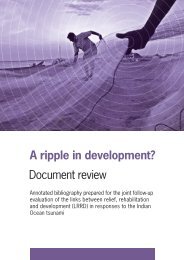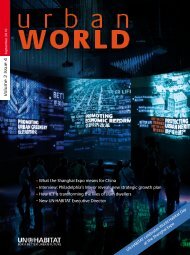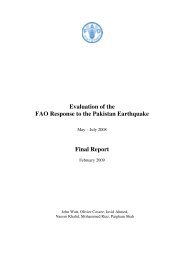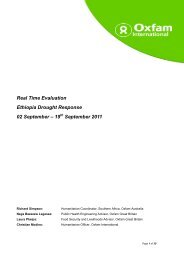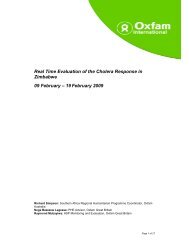Inter-Agency Real Time Evaluation of the Humanitarian ... - alnap
Inter-Agency Real Time Evaluation of the Humanitarian ... - alnap
Inter-Agency Real Time Evaluation of the Humanitarian ... - alnap
You also want an ePaper? Increase the reach of your titles
YUMPU automatically turns print PDFs into web optimized ePapers that Google loves.
7.2 Monitoring<br />
IA RTE <strong>of</strong> <strong>the</strong> humanitarian response to Pakistan’s 2010 Floods crisis<br />
132. The scope <strong>of</strong> <strong>the</strong> disaster has made monitoring a major challenge for UN and cluster<br />
members. None<strong>the</strong>less, basic measures to enhance monitoring have not been applied, including<br />
<strong>the</strong> type <strong>of</strong> information that <strong>the</strong> SRF would bring about. Existing monitoring is <strong>the</strong>refore agency<br />
based, focusing on accountability towards bilateral funding and organisation’s own reporting<br />
needs. For example, UNICEF has contracted a consulting firm to do monitoring and <strong>the</strong> work <strong>of</strong><br />
third party monitors in Balochistan has also been highlighted, but primarily for UNICEF’s own<br />
programming purposes. NGOs are doing monitoring, but within <strong>the</strong> scope <strong>of</strong> <strong>the</strong>ir own<br />
programming purposes.<br />
133. Some monitoring was used as control or surveillance; WPF uses food monitors to oversee<br />
food distribution, which is a demanding task considering <strong>the</strong> number <strong>of</strong> beneficiaries,<br />
unavoidably, <strong>the</strong>re were reports <strong>of</strong> cases <strong>of</strong> unequal food distribution (i.e. not targeting most<br />
vulnerable, political interference with food distribution, etc.). Positive feedback came from <strong>the</strong><br />
health cluster where surveillance teams monitored health‐related issues at local levels with a<br />
high degree <strong>of</strong> embedding <strong>of</strong> <strong>the</strong> same within <strong>the</strong> existing Department <strong>of</strong> Health setup and<br />
involved regular cluster feedback mechanisms. Generally, however, monitoring <strong>of</strong> aid remains a<br />
challenge across many clusters, and where mechanisms have been established, <strong>the</strong>re is still<br />
room for improvement.<br />
134. When <strong>the</strong> evaluation team was fielded, <strong>the</strong>re were no reported cases <strong>of</strong> organisations<br />
doing reporting or monitoring to inform progress at nei<strong>the</strong>r cluster nor inter‐cluster levels. This<br />
means that <strong>the</strong> response plan as such is not being monitored. The PFRERRP envisioned <strong>the</strong><br />
establishment <strong>of</strong> a monitoring system using output and outcome indicators, but <strong>the</strong>re were no<br />
reporting or adequate indicators in place to support such a system (a general recompilation <strong>of</strong><br />
outputs is outlined in annex 7). This means that <strong>the</strong>re is no entity within <strong>the</strong> government or <strong>the</strong><br />
UN system that has <strong>the</strong> necessary oversight <strong>of</strong> <strong>the</strong> assistance provided. Therefore, crucial<br />
questions remain widely unanswered: Where did <strong>the</strong> aid go? Who benefitted and who did not?<br />
Was it useful and did it cover needs (sometimes identified)?<br />
135. Consequently, <strong>the</strong> absence <strong>of</strong> a thorough monitoring system with consolidated<br />
information prevents humanitarian actors from providing <strong>the</strong> affected population, Pakistani<br />
authorities and donors with <strong>the</strong> necessary results and accountability data, mandated to <strong>the</strong>m<br />
under humanitarian reform. Civil society is also sidelined in matters related to accountability as<br />
no platforms or mechanisms exist where <strong>the</strong>ir views and opinions can be raised. These<br />
organisations’ strength varies across <strong>the</strong> different affected areas and streng<strong>the</strong>ning <strong>the</strong>ir<br />
capacity will be instrumental in ensuring that future responses becomes more demand driven<br />
and accountability measures generally streng<strong>the</strong>ned.<br />
Riccardo Polastro, Aatika Nagrah, Nicolai Steen and Farwa Zafar<br />
52







